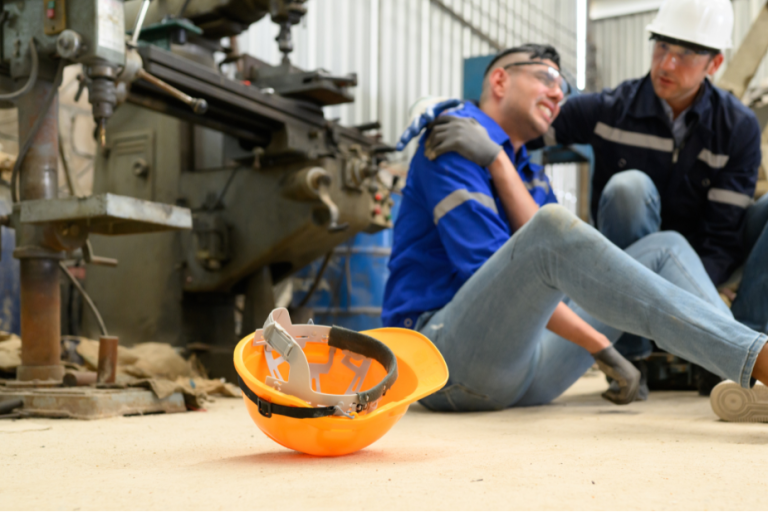Industrial accidents can happen in an instant, but their consequences can last a lifetime. If you’ve been injured in a workplace accident in Queensland, understanding your legal rights is crucial for securing the compensation and support you deserve. At Butler McDermott Lawyers, we’ve helped countless Sunshine Coast residents and Queenslanders navigate the complex legal landscape following industrial accidents.
What Constitutes an Industrial Accident?
An industrial accident refers to any unexpected incident that occurs in a workplace setting, resulting in injury, illness, or death. These accidents are particularly common in high-risk industries such as:
Manufacturing and factory operations
Construction and building sites
Mining and quarrying
Oil and gas facilities
Chemical processing plants
Warehousing and logistics
Transport and heavy machinery operations
Common types of industrial accidents include machinery malfunctions, falls from height, chemical exposures, burns, explosions, crushing injuries, and repetitive strain injuries from prolonged unsafe working conditions.
Immediate Steps After an Industrial Accident
The actions you take immediately after an industrial accident can significantly impact your recovery and potential compensation. Here’s what you should do:
Step 1: Seek Immediate Medical Attention
Don’t delay medical treatment, even if injuries seem minor
Tell the medical professional exactly how the accident occurred
Be honest about all symptoms and pain levels
Request copies of all medical reports and treatment records
Follow all prescribed treatments and attend follow-up appointments
Step 2: Report the Accident
Notify your supervisor or manager immediately
Ensure an official incident report is completed
Get a copy of the incident report for your records
Don’t sign anything without understanding what you’re signing
Report to WorkCover Queensland within 20 working days
Step 3: Document Everything
Take photos of the accident scene if safe to do so
Photograph any equipment or machinery involved
Document your injuries with photos
Write down exactly what happened while it’s fresh in your memory
Keep detailed records of all conversations with supervisors and HR
Step 4: Gather Witness Information
Get contact details from anyone who saw the accident
Ask witnesses to write down what they observed
Don’t discuss fault or blame with anyone
Keep witness statements safe and confidential
Step 5: Preserve Evidence
Don’t allow equipment to be repaired or moved if possible
Keep any damaged personal protective equipment
Save any relevant emails, texts, or documents
Request copies of safety training records
Obtain maintenance logs for any equipment involved
Understanding Your Rights Under Queensland Law
Queensland’s workers’ compensation system provides specific protections for employees injured in industrial accidents. Under the Workers’ Compensation and Rehabilitation Act 2003 (Qld), you have the right to:
Immediate Medical Treatment: Access to necessary medical care without upfront costs, including hospital treatment, specialist consultations, and ongoing rehabilitation services.
Income Support: Weekly compensation payments if your injury prevents you from working, typically calculated as a percentage of your average weekly earnings.
Rehabilitation Services: Access to vocational rehabilitation to help you return to work safely, including retraining if necessary.
Common Law Claims: In certain circumstances, you may be entitled to pursue additional compensation through common law claims for pain and suffering, loss of future earnings, and other damages.
Step-by-Step Guide to Filing Your Workers’ Compensation Claim
Filing a workers’ compensation claim in Queensland involves several important steps:
Step 1: Complete the Worker’s Claim Form
Download the form from WorkCover Queensland’s website
Fill out all sections completely and accurately
Include detailed description of how the accident occurred
Attach all relevant medical certificates and reports
Keep copies of everything you submit
Step 2: Submit Supporting Documentation
Medical certificates from your treating doctor
Incident report from your workplace
Witness statements if available
Photographs of injuries and accident scene
Any correspondence with your employer about the accident
Step 3: Employer Notification
Your employer must complete the Employer’s Report
They have 20 working days to respond to your claim
Follow up if you don’t receive acknowledgment
Keep records of all communications
Step 4: WorkCover Assessment
WorkCover Queensland will review your claim
They may request additional information or medical assessments
Independent medical examinations may be required
Cooperate fully but understand your rights
Step 5: Claim Decision
WorkCover will accept, reject, or request more information
If accepted, benefits will commence
If rejected, you have appeal rights
Legal representation becomes crucial at this stage
Step 6: Ongoing Management
Regular medical reviews may be required
Return to work planning will be discussed
Keep detailed records of all treatments and expenses
Report any changes in your condition immediately
When to Seek Legal Assistance
While workers’ compensation provides essential support, the system can be complex and challenging to navigate alone. Consider seeking legal advice if you experience:
Delays or denials in workers’ compensation claims
Disputes over the extent of your injuries or required treatment
Inadequate compensation offers
Employer retaliation or discrimination following your accident
Uncertainty about your rights to pursue additional compensation
Early legal intervention can significantly impact the outcome of your case. Insurance companies often have teams of lawyers working to minimise payouts, making it essential to have experienced legal representation advocating for your interests.
The Importance of Evidence in Industrial Accident Cases
Building a strong case requires comprehensive evidence collection. This includes:
Immediate Documentation: Report the accident to your supervisor immediately and ensure an incident report is filed. Seek medical attention promptly, even if injuries seem minor initially.
Medical Evidence: Maintain detailed records of all medical treatments, diagnoses, and professional opinions about your condition and prognosis.
Witness Statements: Collect contact information from colleagues who witnessed the accident or can attest to unsafe working conditions.
Workplace Documentation: Preserve safety records, training materials, maintenance logs, and any other documentation relevant to the accident circumstances.
Photographic Evidence: If possible, document the accident scene, equipment involved, and visible injuries.
Common Challenges in Industrial Accident Claims
Industrial accident claims often present unique challenges that require experienced legal guidance:
Proving Negligence: Establishing that your employer or another party failed to provide a safe working environment requires thorough investigation and expert testimony.
Complex Liability Issues: Multiple parties may be responsible for your accident, including employers, equipment manufacturers, contractors, or safety consultants.
Pre-existing Conditions: Insurance companies may argue that your injuries were not caused by the workplace accident, making medical evidence crucial.
Return to Work Pressures: Employers may pressure injured workers to return prematurely, potentially worsening injuries and complicating claims.
Maximising Your Compensation
The compensation you receive should reflect the full impact of your injuries on your life. This may include:
All medical expenses, including ongoing treatment and rehabilitation
Lost wages and reduced earning capacity
Pain and suffering
Loss of enjoyment of life
Domestic assistance and care costs
Modifications to your home or vehicle
An experienced industrial accident lawyer can ensure all aspects of your damages are properly valued and pursued.
Timeline: What to Expect During Your Claim Process
Understanding the typical timeline can help you prepare for the claim process:
Week 1-2: Initial Response
Medical treatment begins
Accident reported to employer and WorkCover
Initial documentation gathered
Employer processes internal reports
Week 3-4: Formal Claim Submission
Workers’ compensation claim lodged
Supporting documentation submitted
Employer provides their response
WorkCover begins preliminary assessment
Month 2-3: Assessment Period
WorkCover reviews all documentation
Additional medical information may be requested
Independent medical examinations scheduled if required
Decision pending notification sent
Month 3-4: Initial Decision
WorkCover makes initial determination
Benefits commence if claim accepted
Appeal process begins if claim rejected
Legal representation becomes essential for disputes
Month 4-12: Ongoing Management
Regular medical reviews conducted
Return to work planning initiated
Benefit payments continue
Potential common law assessment begins
Month 12+: Long-term Resolution
Final medical assessments completed
Common law claims may be pursued
Settlement negotiations possible
Final resolution achieved
Important Note: Complex cases or disputed claims can take significantly longer. Having legal representation from the beginning can help expedite the process and ensure you receive all benefits you’re entitled to.
Why Choose Butler McDermott Lawyers
Located on the Sunshine Coast, Butler McDermott Lawyers brings decades of experience to industrial accident cases throughout Queensland. Our approach combines:
Local Knowledge: Deep understanding of Queensland’s workers’ compensation system and local court procedures.
Specialised Experience: Extensive experience handling complex industrial accident cases across various industries.
Personalised Service: Direct access to experienced lawyers who understand the unique challenges you face.
No Win, No Fee: Many industrial accident cases can be handled on a no win, no fee basis, ensuring access to quality legal representation regardless of your financial situation.
Proven Results: A track record of securing substantial compensation for injured workers and their families.
Taking Action After an Industrial Accident
Time is critical in industrial accident cases. Queensland law imposes strict time limits for lodging workers’ compensation claims and pursuing common law actions. Generally, you have:
Six months to lodge statutory claim with WorkCover Qld. As a matter of prudence, the employer should be notified immediately of a workplace injury.
Three years to commence common law proceedings
Acting quickly also helps preserve evidence and witness memories, strengthening your case.
Moving Forward: Your Next Steps
If you’ve been injured in an industrial accident, don’t navigate this challenging time alone. The legal team at Butler McDermott Lawyers is here to guide you through every step of the process, from initial claim lodgement to final settlement or court judgment.
We understand that industrial accidents don’t just affect the injured worker, they impact entire families. Our compassionate approach ensures you receive not only expert legal representation but also the support you need during your recovery.
Contact Butler McDermott Lawyers today for a confidential consultation about your industrial accident case. Let us help you secure the compensation and justice you deserve, so you can focus on what matters most, your recovery and your future.





















